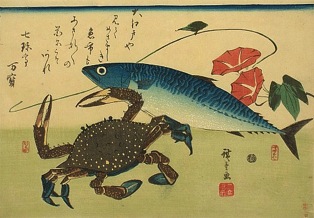Of cylindrical form raised on bamboo tapered feet, the lower body applied with a geometric pattern border, the body inlaid with a copper and niello underwater scene of fish, a crab, insects and water lilies, marked on underside Tiffany & Co., 2983/5284, Sterling-Silver, 925-1000 M
7 ½ in (19.1 cm) high
cf. John Loring, Magnificent Tiffany Silver, 2001, p. 132 - for a photograph of a vase of similar form and decoration displayed at the Philadelphia Centennial Exhibition in 1876
Moore’s early work in the 1850s and 1860s was well-made, but not particularly inspired. He worked largely in the Rococo and Classical Revival styles that were popular at the time, both in Europe and America. It was only in 1856 – the year of publication of Owen Jones’ influential book The Grammar of Ornament – that Moore began to develop a personal style, based in large part on the Orientalist designs extolled by Jones. However, only a few years later, the Civil War began, and little work was produced by Moore or Tiffany’s in the early 1860s as a result.
It was therefore not until 1867 that Tiffany’s silver came into its own, exhibited at the Paris Exposition. Here the company showed a ‘Moresque’ tea set designed by Moore, a design in keeping with the exposition’s overall theme of ‘Orientalism’ (and it is notable that this was the first European exposition in which the Japanese themselves had a significant presence). Tiffany & Co. won a bronze medal – the first time an American designer had been given an award by a foreign jury. Meanwhile, Moore was able to take first-hand inspiration from a wide selection of Japanese and Middle Eastern pieces. He continued to collect these pieces throughout his life, both through dealers in Europe, and through the British designer Christopher Dresser, who himself undertook several trips to Japan.
Following the Paris Exposition, Moore’s imagination was fired and his designs became increasingly unusual and complex. In 1871, he patented the first design in his new ‘Japanesque’ style. This style, together with his Middle Eastern-inspired pieces, became Moore’s mainstay and a trademark of Tiffany’s silver at this time. Despite his important role in American design reform, Moore was a retiring man rather than a self-publicist like Louis Comfort Tiffany (who had succeeded his father in the business). Moore’s personality, along with the Tiffany custom of designer anonymity, meant that Moore’s achievements were little known in America, and much less abroad.
As Moore’s style evolved throughout the 1870s and 1880s, his pieces increased in popularity. Indeed, the Japanese themselves took Tiffany’s products seriously as competition in the market, particularly after Moore introduced the Japanese technique of mokume, using mixed metal enamels in his pieces.
This vase shows the early stage of Moore’s ‘Japanesque’ design, with its smooth background and incised decoration, and just a few applied decorative features around the base. The shape may have been inspired by a cylindrical Japanese Kyoto-ware brush pot Moore had in his own collection (today at the Metropolitan Museum of Art). This suggests that Moore drew on original pieces and first-hand observation as well as broader aesthetic theories to create his designs. A vase of similar form and decoration is shown in a contemporary photograph of Tiffany’s exhibits at the Centennial Exhibition in Philadelphia in 1876.



















